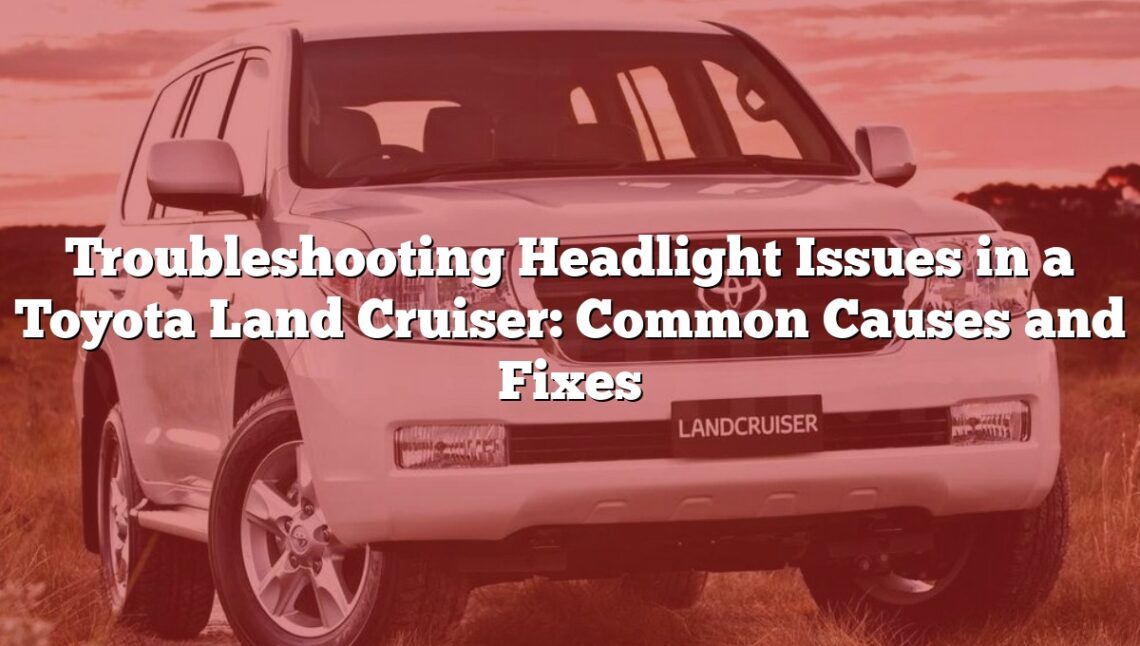Headlights are a critical component of any vehicle, especially for a reliable and rugged SUV like the Toyota Land Cruiser. Whether it’s flickering lights, uneven beams, or complete failures, headlight problems can compromise safety and visibility. This guide explores the most common causes of headlight issues and provides practical, step-by-step solutions to help you quickly restore optimal performance.
Comprehensive Troubleshooting Guide for Toyota Land Cruiser Headlights: Problems and Their Solutions
| N° | Problem/Cause | Solution |
|---|---|---|
| 1 | Blown headlight bulbs | Replace the bulbs with compatible ones. |
| 2 | Faulty headlight relay | Replace the faulty relay with a new one. |
| 3 | Damaged wiring harness | Inspect and repair or replace the damaged harness. |
| 4 | Corroded or loose electrical connections | Clean and tighten the connections, replace corroded parts if needed. |
| 5 | Faulty headlight switch | Replace the defective switch. |
| 6 | Malfunctioning fuse | Replace the blown fuse with the correct amperage. |
| 7 | Battery issues | Test and recharge or replace the battery. |
| 8 | Alternator malfunction | Inspect and repair or replace the alternator. |
| 9 | Grounding issues | Check grounding points and secure or clean as necessary. |
| 10 | Moisture or water ingress in headlight housing | Dry the housing, seal any gaps, and replace if needed. |
| 11 | Faulty light control module | Diagnose and replace the defective module. |
| 12 | Aging or oxidized headlight lenses | Clean or replace the lenses. |
| 13 | Overheated or melted connectors | Replace damaged connectors and inspect for further issues. |
| 14 | Defective dimmer switch | Replace the malfunctioning dimmer switch. |
| 15 | Voltage irregularities | Test and stabilize the voltage with a voltage regulator. |
| 16 | Software or ECU glitches | Update or reset the ECU software. |
| 17 | Aftermarket installation issues | Verify compatibility and reinstall the components correctly. |
| 18 | Use of incompatible bulbs | Replace with bulbs specified in the manual. |
| 19 | Broken or damaged headlight mounting | Repair or replace the mounting brackets or assembly. |
| 20 | Internal headlight assembly damage | Replace the headlight assembly. |
| 21 | Short circuit in the system | Locate and repair the short circuit. |
| 22 | Environmental wear and tear | Inspect and replace worn-out components. |
| 23 | Physical damage from collisions or debris | Repair or replace damaged parts. |
| 24 | Overloaded electrical system | Reduce electrical load and inspect for system damage. |
| 25 | Sensor or adaptive headlight system failure | Diagnose with specialized tools and replace faulty sensors. |
| 26 | Flickering headlights due to loose connection or failing ballast | Tighten connections or replace the ballast. |
| 27 | Delayed or dim startup caused by ballast or bulb issues | Replace the ballast or bulbs as required. |
| 28 | Headlight turning off randomly while driving | Check and replace faulty wiring, ballast, or bulb. |
| 29 | Uneven beam pattern due to improper alignment or faulty ballast | Adjust alignment or replace the ballast. |
| 30 | Random power cycling caused by damaged wiring or ballast | Inspect and replace the ballast or wiring as necessary. |
| 31 | Burned-out fuses | Replace the fuse and inspect the system for underlying issues. |
| 32 | Faulty relays | Test and replace the malfunctioning relay. |
| 33 | Faulty or damaged HID ballast | Replace the defective ballast. |
| 34 | Misaligned bulb or reflector assembly | Adjust the bulb or reflector alignment properly. |
Detailed Guide for Toyota Land Cruiser Headlights: Problems and Their Solutions
1. Blown headlight bulbs
Reason:
- Headlight bulbs can burn out due to prolonged use or exposure to high electrical loads.
Solution:
- Replace the bulb with a new one.
Steps:- Turn off the vehicle and ensure the lights are cool.
- Access the back of the headlight assembly.
- Remove the old bulb by twisting it counterclockwise.
- Install a new, compatible bulb and twist it clockwise to secure it.
2. Faulty headlight relay
Reason:
- The relay may fail due to electrical surges or wear over time.
Solution:
- Replace the relay.
Steps:- Locate the relay in the fuse box.
- Remove the old relay and replace it with one of the same specifications.
3. Damaged wiring harness
Reason:
- Wires can be damaged by rodents, wear, or improper installation.
Solution:
- Inspect and repair the damaged sections or replace the harness.
Steps:- Disconnect the power supply.
- Identify and replace damaged sections using compatible connectors or shrink tubes.
4. Corroded or loose electrical connections
Reason:
- Moisture or environmental exposure can cause corrosion or loosen connections.
Solution:
- Clean and tighten connections.
Steps:- Disconnect the battery.
- Use a wire brush or electrical cleaner to remove corrosion.
- Reconnect and secure the connections.
5. Faulty headlight switch
Reason:
- The switch may wear out due to repeated use.
Solution:
- Replace the faulty switch.
Steps:- Remove the dashboard panel.
- Disconnect the switch wiring.
- Install a new switch and reassemble the panel.
6. Malfunctioning fuse
Reason:
- Fuses can blow due to a surge or short circuit.
Solution:
- Replace the blown fuse.
Steps:- Locate the fuse in the fuse box using the owner’s manual.
- Replace it with one of the same amperage.
7. Battery issues
Reason:
- A weak or failing battery can cause inconsistent power delivery to headlights.
Solution:
- Recharge or replace the battery.
Steps:- Test the battery voltage with a multimeter.
- Recharge if the voltage is low or replace if it cannot hold a charge.
8. Alternator malfunction
Reason:
- A faulty alternator may not provide adequate power to the headlights.
Solution:
- Inspect and repair or replace the alternator.
Steps:- Test the alternator output with a multimeter.
- Replace it if it is underperforming.
9. Grounding issues
Reason:
- Poor grounding can lead to dim or flickering lights.
Solution:
- Secure and clean the grounding connections.
Steps:- Locate the grounding points.
- Clean and tighten them.
10. Moisture or water ingress in headlight housing
Reason:
- Damaged seals can allow water to enter and affect the bulbs.
Solution:
- Dry the housing and seal any gaps.
Steps:- Remove the housing and dry it with a hairdryer.
- Apply sealant around the edges to prevent further ingress.
11. Faulty light control module
Reason:
- The control module may malfunction due to electrical issues.
Solution:
- Replace the control module.
Steps:- Locate the module using the owner’s manual.
- Disconnect the old module and replace it.
12. Aging or oxidized headlight lenses
Reason:
- Lenses can yellow or oxidize over time, reducing brightness.
Solution:
- Clean or replace the lenses.
Steps:- Use a headlight restoration kit to clean them.
- Replace them if cleaning is ineffective.
13. Overheated or melted connectors
Reason:
- High temperatures can damage connectors.
Solution:
- Replace damaged connectors.
Steps:- Cut out the damaged connector.
- Splice in a new connector with crimping tools.
14. Defective dimmer switch
Reason:
- The switch may fail, preventing brightness adjustment.
Solution:
- Replace the dimmer switch.
Steps:- Access the switch via the dashboard.
- Replace it with a new one.
15. Voltage irregularities
Reason:
- Unstable voltage can harm the headlight system.
Solution:
- Use a voltage regulator or replace faulty components.
Steps:- Test the electrical system with a multimeter.
- Repair or replace the affected parts.
16. Software or ECU glitches
Reason:
- Headlight operation may be affected by ECU programming errors or software bugs.
Solution:
- Reset or update the ECU software.
Steps:- Use a diagnostic tool to check for software updates or error codes.
- Perform an update or reset the ECU.
17. Aftermarket installation issues
Reason:
- Poorly installed aftermarket headlights can cause performance problems.
Solution:
- Reinstall or replace with compatible components.
Steps:- Verify compatibility with vehicle specifications.
- Correct wiring and ensure secure connections.
18. Use of incompatible bulbs
Reason:
- Incompatible bulbs can cause electrical overload or insufficient brightness.
Solution:
- Replace with manufacturer-recommended bulbs.
Steps:- Refer to the owner’s manual for the correct specifications.
- Install the specified bulbs.
19. Broken or damaged headlight mounting
Reason:
- Physical damage can misalign or loosen the headlight assembly.
Solution:
- Repair or replace the mounting bracket.
Steps:- Inspect for visible damage.
- Replace the damaged parts to secure the assembly.
20. Internal headlight assembly damage
Reason:
- Components inside the assembly may fail due to impact or wear.
Solution:
- Replace the entire headlight assembly.
Steps:- Remove the old assembly following the manual’s instructions.
- Install a new assembly.
21. Short circuit in the system
Reason:
- Faulty wiring or connectors can cause a short circuit.
Solution:
- Locate and repair the short.
Steps:- Use a multimeter to trace the circuit.
- Repair or replace the damaged section.
22. Environmental wear and tear
Reason:
- Prolonged exposure to harsh conditions can degrade components.
Solution:
- Inspect and replace worn-out parts.
Steps:- Identify corroded or brittle parts.
- Replace as necessary.
23. Physical damage from collisions or debris
Reason:
- Impacts can damage the housing or internal components.
Solution:
- Repair or replace the affected parts.
Steps:- Assess the extent of damage.
- Replace housing or internal components as needed.
24. Overloaded electrical system
Reason:
- Adding too many accessories can strain the system.
Solution:
- Reduce the electrical load.
Steps:- Disconnect unnecessary accessories.
- Upgrade the electrical system if additional accessories are needed.
25. Sensor or adaptive headlight system failure
Reason:
- Sensors can malfunction, impacting headlight alignment or brightness.
Solution:
- Replace faulty sensors.
Steps:- Use a diagnostic tool to identify sensor issues.
- Replace defective sensors and recalibrate the system.
26. Flickering headlights due to loose connection or failing ballast
Reason:
- Flickering can occur from poor connections or a defective ballast.
Solution:
- Tighten connections or replace the ballast.
Steps:- Check all connections for tightness.
- Replace the ballast if flickering persists.
27. Delayed or dim startup caused by ballast or bulb issues
Reason:
- Faulty ballast or bulbs can delay illumination.
Solution:
- Replace the ballast or bulbs.
Steps:- Swap the suspected components to identify the faulty one.
- Replace the defective component.
28. Headlight turning off randomly while driving
Reason:
- Intermittent power loss from wiring or ballast issues.
Solution:
- Inspect and repair wiring or replace the ballast.
Steps:- Trace wiring for loose or damaged connections.
- Replace faulty components.
29. Uneven beam pattern due to improper alignment or faulty ballast
Reason:
- Misalignment or ballast issues can skew the beam.
Solution:
- Adjust alignment or replace the ballast.
Steps:- Realign the bulb using adjustment screws.
- Replace the ballast if alignment is correct but the issue persists.
30. Random power cycling caused by damaged wiring or ballast
Reason:
- Faulty wiring or ballast can cause on/off cycling.
Solution:
- Replace the ballast or repair the wiring.
Steps:- Inspect the wiring harness for damage.
- Replace the damaged ballast if necessary.
31. Burned-out fuses
Reason:
- A power surge or short can blow the fuse.
Solution:
- Replace the fuse and check for underlying issues.
Steps:- Replace the fuse with one of the correct amperage.
- Test the circuit to ensure no recurring issues.
32. Faulty relays
Reason:
- Relays may fail due to electrical stress.
Solution:
- Replace the relay.
Steps:- Identify the faulty relay in the fuse box.
- Install a new relay.
33. Faulty or damaged HID ballast
Reason:
- The ballast may fail due to heat or electrical wear.
Solution:
- Replace the ballast.
Steps:- Remove the defective ballast.
- Install a new ballast.
34. Misaligned bulb or reflector assembly
Reason:
- Misalignment reduces effective light distribution.
Solution:
- Adjust the alignment.
Steps:- Use the adjustment screws to realign the assembly.
- Test the beam on a flat surface for accuracy.
Preventing Future Issues
To keep your Toyota Land Cruiser’s headlights in optimal condition and avoid future problems, follow these preventive steps:
- Regular Inspection:
- Check the headlights monthly for signs of dimness, flickering, or physical damage.
- Look for moisture buildup inside the headlight housing and address it promptly.
- Clean the Headlight Lenses:
- Use a microfiber cloth and a headlight cleaning solution to remove dirt and grime.
- Apply a UV-protective coating to prevent oxidation and yellowing of the lenses.
- Check Electrical Connections:
- Inspect wiring and connectors every 6 months for signs of corrosion or looseness.
- Tighten or replace any compromised connections.
- Replace Bulbs in Pairs:
- If one bulb burns out, replace both bulbs to ensure uniform brightness and reduce the likelihood of frequent replacements.
- Seal the Housing:
- After any maintenance, ensure that all seals and gaskets are properly installed to prevent moisture ingress.
- Use Manufacturer-Recommended Components:
- Stick to Toyota-approved bulbs, ballasts, and other parts to maintain compatibility and reliability.
- Avoid Overloading the Electrical System:
- Limit the addition of aftermarket accessories that can strain the electrical system.
- Upgrade the alternator or battery if additional accessories are necessary.
- Protect from Physical Damage:
- Use headlight covers or protective films to shield the headlights from debris and minor impacts.
- Test the Charging System Regularly:
- Ensure the battery and alternator are functioning correctly to provide stable power to the headlights.
- Perform Professional Inspections:
- Schedule a yearly inspection with a qualified technician to check the headlight system thoroughly and address potential issues before they escalate.
By following these steps, you can ensure long-lasting performance and safety from your Toyota Land Cruiser’s headlights. Regular maintenance not only prevents costly repairs but also enhances visibility and driving safety.







